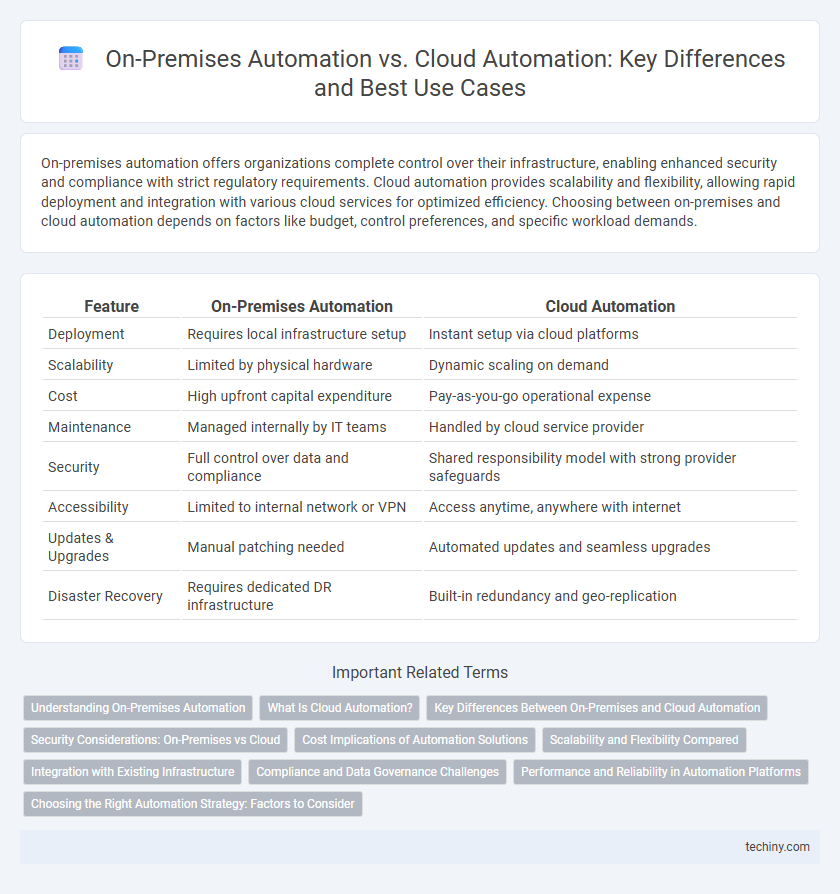On-premises automation offers organizations complete control over their infrastructure, enabling enhanced security and compliance with strict regulatory requirements. Cloud automation provides scalability and flexibility, allowing rapid deployment and integration with various cloud services for optimized efficiency. Choosing between on-premises and cloud automation depends on factors like budget, control preferences, and specific workload demands.
Table of Comparison
| Feature | On-Premises Automation | Cloud Automation |
|---|---|---|
| Deployment | Requires local infrastructure setup | Instant setup via cloud platforms |
| Scalability | Limited by physical hardware | Dynamic scaling on demand |
| Cost | High upfront capital expenditure | Pay-as-you-go operational expense |
| Maintenance | Managed internally by IT teams | Handled by cloud service provider |
| Security | Full control over data and compliance | Shared responsibility model with strong provider safeguards |
| Accessibility | Limited to internal network or VPN | Access anytime, anywhere with internet |
| Updates & Upgrades | Manual patching needed | Automated updates and seamless upgrades |
| Disaster Recovery | Requires dedicated DR infrastructure | Built-in redundancy and geo-replication |
Understanding On-Premises Automation
On-premises automation involves deploying and managing automation tools within a company's own data center, providing greater control over security, compliance, and customization. This approach allows organizations to integrate automation processes tightly with existing infrastructure and legacy systems, ensuring low latency and high reliability. Despite higher upfront costs and maintenance requirements, on-premises automation offers enhanced data privacy and control compared to cloud-based alternatives.
What Is Cloud Automation?
Cloud automation leverages cloud computing technologies to automate IT processes, enabling dynamic resource provisioning, management, and scaling without manual intervention. It enhances operational efficiency by using APIs, machine learning, and orchestration tools to handle workloads in public, private, or hybrid cloud environments. This approach contrasts with on-premises automation by offering greater flexibility, reduced infrastructure costs, and seamless integration across distributed systems.
Key Differences Between On-Premises and Cloud Automation
On-premises automation involves deploying automation tools within a company's local data center, offering greater control, customization, and security for sensitive operations. Cloud automation leverages cloud service providers to facilitate scalable, flexible, and cost-effective automation workflows without the need for extensive infrastructure management. Key differences include initial infrastructure investment, scalability options, maintenance responsibility, and data governance, with on-premises requiring higher upfront costs and self-managed security, while cloud automation enables rapid deployment and managed services with ongoing subscription fees.
Security Considerations: On-Premises vs Cloud
On-premises automation offers enhanced control over data security through localized infrastructure, allowing organizations to enforce strict access policies and comply with regulatory requirements. Cloud automation provides scalable, managed security services like encryption, threat detection, and compliance certifications but introduces risks related to data sovereignty and multi-tenant environments. Assessing security trade-offs involves evaluating factors such as physical access controls, incident response capabilities, and vendor trust models to align with organizational risk tolerance and compliance standards.
Cost Implications of Automation Solutions
On-premises automation demands significant upfront capital expenditure for hardware, software licenses, and maintenance, leading to higher total cost of ownership compared to cloud automation. Cloud automation offers a pay-as-you-go model, reducing initial investments and enabling scalable, cost-efficient operations through dynamic resource allocation. Long-term operational expenses vary, with on-premises solutions incurring continuous infrastructure costs, while cloud platforms may present variable costs influenced by usage patterns and service providers.
Scalability and Flexibility Compared
On-premises automation offers controlled environments but faces limitations in scalability due to fixed hardware resources and infrastructure constraints. Cloud automation provides superior scalability and flexibility by leveraging elastic computing power and on-demand resource allocation, facilitating rapid adjustments to workload fluctuations. Enterprises benefit from cloud automation's ability to dynamically scale operations and integrate diverse tools, enabling agile responses to evolving business requirements.
Integration with Existing Infrastructure
On-premises automation offers direct integration with existing legacy systems and hardware, enabling organizations to maintain control over their data and security while leveraging current infrastructure investments. Cloud automation provides scalability and flexibility through API-driven connectivity, simplifying integration with diverse platforms and enabling seamless updates without disrupting ongoing operations. Choosing between the two depends on the organization's infrastructure complexity, security requirements, and need for rapid deployment.
Compliance and Data Governance Challenges
On-premises automation provides organizations with greater control over data storage and compliance by keeping sensitive information within their own infrastructure, which simplifies adherence to strict regulatory frameworks such as GDPR and HIPAA. Cloud automation introduces challenges related to data sovereignty, shared responsibility models, and varying compliance standards across regions, making it essential for businesses to thoroughly evaluate their cloud provider's certifications and governance policies. Effective data governance in cloud automation requires robust encryption, access controls, and continuous monitoring to mitigate risks associated with data breaches and regulatory non-compliance.
Performance and Reliability in Automation Platforms
On-premises automation platforms deliver enhanced performance by leveraging dedicated local infrastructure, reducing latency and increasing processing speed critical for time-sensitive tasks. Cloud automation offers superior reliability through distributed architectures and built-in disaster recovery, ensuring continuous uptime and scalability during demand spikes. Organizations often balance the low latency of on-premises systems with the elasticity and fault tolerance provided by cloud automation solutions.
Choosing the Right Automation Strategy: Factors to Consider
Choosing the right automation strategy requires evaluating infrastructure control, security requirements, and scalability needs. On-premises automation offers greater customization and control for sensitive data environments, while cloud automation provides flexibility, rapid deployment, and cost-efficiency for dynamic workloads. Assessing compliance regulations, integration complexity, and long-term maintenance costs ensures alignment with business objectives and operational demands.
On-Premises Automation vs Cloud Automation Infographic

 techiny.com
techiny.com